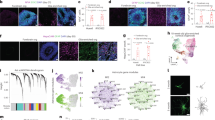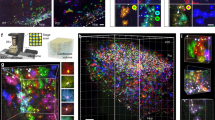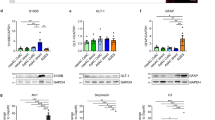Abstract
The subventricular zone (SVZ) is a principal source of adult neural stem cells in the rodent brain, generating thousands of olfactory bulb neurons every day1. If the adult human brain contains a comparable germinal region, this could have considerable implications for future neuroregenerative therapy. Stem cells have been isolated from the human brain2,3,4,5,6,7, but the identity, organization and function of adult neural stem cells in the human SVZ are unknown. Here we describe a ribbon of SVZ astrocytes lining the lateral ventricles of the adult human brain that proliferate in vivo and behave as multipotent progenitor cells in vitro. This astrocytic ribbon has not been observed in other vertebrates studied. Unexpectedly, we find no evidence of chains of migrating neuroblasts in the SVZ or in the pathway to the olfactory bulb. Our work identifies SVZ astrocytes as neural stem cells in a niche of unique organization in the adult human brain.
This is a preview of subscription content, access via your institution
Access options
Subscribe to this journal
Receive 51 print issues and online access
$199.00 per year
only $3.90 per issue
Buy this article
- Purchase on Springer Link
- Instant access to full article PDF
Prices may be subject to local taxes which are calculated during checkout




Similar content being viewed by others
References
Alvarez-Buylla, A., Garcia-Verdugo, J. M. & Tramontin, A. D. A unified hypothesis on the lineage of neural stem cells. Nature Rev. Neurosci. 2, 287–293 (2001)
Pincus, D. W. et al. In vitro neurogenesis by adult human epileptic temporal neocortex. Clin. Neurosurg. 44, 17–25 (1997)
Roy, N. S. et al. Promoter-targeted selection and isolation of neural progenitor cells from the adult human ventricular zone. J. Neurosci. Res. 59, 321–331 (2000)
Johansson, C. B., Svensson, M., Wallstedt, L., Janson, A. M. & Frisen, J. Neural stem cells in the adult human brain. Exp. Cell Res. 253, 733–736 (1999)
Pagano, S. F. et al. Isolation and characterization of neural stem cells from the adult human olfactory bulb. Stem Cells 18, 295–300 (2000)
Nunes, M. C. et al. Identification and isolation of multipotential neural progenitor cells from the subcortical white matter of the adult human brain. Nature Med. 9, 439–447 (2003)
Kukekov, V. G. et al. Multipotent stem/progenitor cells with similar properties arise from two neurogenic regions of adult human brain. Exp. Neurol. 156, 333–344 (1999)
Kornack, D. R. & Rakic, P. The generation, migration, and differentiation of olfactory neurons in the adult primate brain. Proc. Natl Acad. Sci. USA 98, 4752–4757 (2001)
Alvarez-Buylla, A. & Garcia-Verdugo, J. M. Neurogenesis in adult subventricular zone. J. Neurosci. 22, 629–634 (2002)
Pencea, V., Bingaman, K. D., Freedman, L. J. & Luskin, M. B. Neurogenesis in the subventricular zone and rostral migratory stream of the neonatal and adult primate forebrain. Exp. Neurol. 172, 1–16 (2001)
Doetsch, F., Caille, I., Lim, D. A., Garcia-Verdugo, J. M. & Alvarez-Buylla, A. Subventricular zone astrocytes are neural stem cells in the adult mammalian brain. Cell 97, 703–716 (1999)
Laywell, E. D., Rakic, P., Kukekov, V. G., Holland, E. C. & Steindler, D. A. Identification of a multipotent astrocytic stem cell in the immature and adult mouse brain. Proc. Natl Acad. Sci. USA 97, 13883–13888 (2000)
Skogh, C. et al. Generation of regionally specified neurons in expanded glial cultures derived from the mouse and human lateral ganglionic eminence. Mol. Cell. Neurosci. 17, 811–820 (2001)
Imura, T., Kornblum, H. I. & Sofroniew, M. V. The predominant neural stem cell isolated from postnatal and adult forebrain but not early embryonic forebrain expresses GFAP. J. Neurosci. 23, 2824–2832 (2003)
Reynolds, B. A. & Weiss, S. Generation of neurons and astrocytes from isolated cells of the adult mammalian central nervous system. Science 255, 1707–1710 (1992)
Chiasson, B. J., Tropepe, V., Morshead, C. M. & van der Kooy, D. Adult mammalian forebrain ependymal and subependymal cells demonstrate proliferative potential, but only subependymal cells have neural stem cell characteristics. J. Neurosci. 19, 4462–4471 (1999)
Gritti, A. et al. Multipotent neural stem cells reside into the rostral extension and olfactory bulb of adult rodents. J. Neurosci. 22, 437–445 (2002)
Kirschenbaum, B. et al. In vitro neuronal production and differentiation by precursor cells derived from the adult human forebrain. Cereb. Cortex 4, 576–589 (1994)
Palmer, T. D. et al. Cell culture. Progenitor cells from human brain after death. Nature 411, 42–43 (2001)
Doetsch, F., Garcia-Verdugo, J. M. & Alvarez-Buylla, A. Cellular composition and three-dimensional organization of the subventricular germinal zone in the adult mammalian brain. J. Neurosci. 17, 5046–5061 (1997)
Blakemore, W. F. & Jolly, R. D. The subependymal plate and associated ependyma in the dog. An ultrastructural study. J. Neurocytol. 1, 69–84 (1972)
Perez-Martin, M. et al. Ependymal explants from the lateral ventricle of the adult bovine brain: a model system for morphological and functional studies of the ependyma. Cell Tissue Res. 300, 11–19 (2000)
Eriksson, P. S. et al. Neurogenesis in the adult human hippocampus. Nature Med. 4, 1313–1317 (1998)
Lim, D. A. & Alvarez-Buylla, A. Interaction between astrocytes and adult subventricular zone precursors stimulates neurogenesis. Proc. Natl Acad. Sci. USA 96, 7526–7531 (1999)
Song, H., Stevens, C. F. & Gage, F. H. Astroglia induce neurogenesis from adult neural stem cells. Nature 417, 39–44 (2002)
Lois, C., Garcia-Verdugo, J. M. & Alvarez-Buylla, A. Chain migration of neuronal precursors. Science 271, 978–981 (1996)
Bonfanti, L., Peretto, P., Merighi, A. & Fasolo, A. Newly-generated cells from the rostral migratory stream in the accessory olfactory bulb of the adult rat. Neuroscience 81, 489–502 (1997)
Leel-Ossy, L. & Gati, I. Corpus amylaceum (polyglucosan body) in the peripheral olfactory system. Pathol. Oncol. Res. 4, 212–216 (1998)
Smith, K. R., Frank, K. J. & Bucholz, R. D. The NeuroStation—a highly accurate, minimally invasive solution to frameless stereotactic neurosurgery. Comput. Med. Imaging Graph. 18, 247–256 (1994)
McCarthy, K. D. & de Vellis, J. Preparation of separate astroglial and oligodendroglial cell cultures from rat cerebral tissue. J. Cell Biol. 85, 890–902 (1980)
Acknowledgements
We thank G. E. Vates and J. W. Chiong for comments on the manuscript; A. Bollen, D. Gaskin, T. Tihan and S. R. VandenBerg for assistance with pathology material; A. Leong for stealth neuronavigational imagery; and Z. Mirzadeh for imaging. This work was supported by a gift from Frances and John Bowes, by the William Siebrandt Glioblastoma Fund and grants from the NIH. A.A-B. is the Heather and Melanie Muss Professor. N.S. is supported by the HHMI and an American Brain Tumor Association David B. Anderson Fellowship. A.D.T. is supported by the Damon Runyon Cancer Research Foundation.
Author information
Authors and Affiliations
Corresponding authors
Ethics declarations
Competing interests
The authors declare that they have no competing financial interests.
Supplementary information
Supplementary Methods
Additional methodological information regarding the quantification of cell proliferation and calculation of astrocyte growth curves. (DOC 19 kb)
Supplementary Table 1
List of collected intraoperative human specimens. (PDF 23 kb)
Supplementary Table 2
List of collected autopsied human specimens. (PDF 21 kb)
Rights and permissions
About this article
Cite this article
Sanai, N., Tramontin, A., Quiñones-Hinojosa, A. et al. Unique astrocyte ribbon in adult human brain contains neural stem cells but lacks chain migration. Nature 427, 740–744 (2004). https://doi.org/10.1038/nature02301
Received:
Accepted:
Issue Date:
DOI: https://doi.org/10.1038/nature02301
This article is cited by
-
Subventricular zone cytogenesis provides trophic support for neural repair in a mouse model of stroke
Nature Communications (2023)
-
The ventricular-subventricular, subgranular and subcallosal zones: three niches of neural stem cells in the postnatal brain
Experimental Brain Research (2023)
-
Loss of p53 Concurrent with RAS and TERT Activation Induces Glioma Formation
Molecular Neurobiology (2023)
-
Glioblastoma disrupts the ependymal wall and extracellular matrix structures of the subventricular zone
Fluids and Barriers of the CNS (2022)
-
Identifying gene expression profiles associated with neurogenesis and inflammation in the human subependymal zone from development through aging
Scientific Reports (2022)
Comments
By submitting a comment you agree to abide by our Terms and Community Guidelines. If you find something abusive or that does not comply with our terms or guidelines please flag it as inappropriate.



